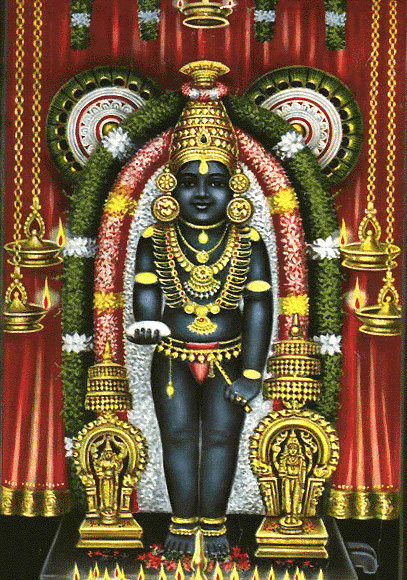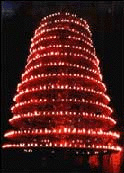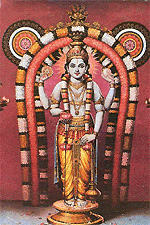Sri Guruvayurappan
BY: HARI KRISHNAN

Sep 13, CANADA (SUN) — Lord Krishna (Narayana) is enshrined in Guruvayur, a shrine that is believed to cure all incurable diseases and is thronged by devotees round the year. Situated about 30 km. from Trichur, South Malabar, Guruvayur is a simple structure as compared to many other temples of India but nonetheless has its own charm about it. The name Guruvayur is derived from Guru, Brihaspati, who is the revered preceptor of Devas and Vayu, Wind.
There are two versions as to how the names of Guru and Vayu came to be associated with this shrine. The Deity installed in the temple was originally installed in Dwarka and was worshipped by Lord Brahma, who gifted it to Lord Vishnu. At the end of the Mahabharata war, due to the curse of sage Dhurvasa, the Yadavas, the clan in which Krishna was brought up, quarrelled among themselves and died, while Dwarka was submerged under the sea. But before this event, Krishna instructed Uddava to ask Guru and Vayu to remove the Deity to a safer place and install it there. Accordingly they consecrated the idol in this place near a lake full of lotuses, with Shiva and Parvati on one side.
It is also said that King Janamejaya, the great grandson of Arjuna, performed the Sarpa Yaga, in which he killed hundreds of thousands of serpents to avenge for the death of his father Parikshit, son of Abhimanyu, by snake bite. Because of this sin of killing serpents in their hordes, Janamejaya was afflicted with leprosy. He was then advised to worship the image of Lord Krishna which was lying submerged under the ocean in Dwarka, installing it in an appropriate place so that his disease may be cured.
With due efforts the idol was retrieved and with the help of Guru and Vayu it was installed here. King Janamejaya performed a long penance before Guruvayurappan and was cured of his disease.
The temple

Though the well-maintained structure does not wear a worn-out appearance, it may safely be concluded that it must have been in existence at least from the 16th century AD going by the fact that Narayana Bhatta wrote his celebrated Narayaniyam by the end of the 16th century.
The temple had been through ups and downs during the days of invasion. When Tippu Sultan invaded the area in 1789 AD, the idol was removed to Ambalapuzha in Travancore and was worshipped there for around two years. A small shrine exists in Ambalapuzha even to this day, where the king of Travancore has arranged to offer daily naivedhya in memory of the event.
Devotees enter the temple in Guruvayur by the eastern entrance. The sanctum sanctorum is known as Srikoil. Entry into the sanctum sanctorum is permitted only for the priests - Melsanthi, Tantri, Othikkan and Keezhsanti. All the other devotees get a darshan of the Lord only from some distance away.
The Deity

Though The Krishna idol in Guruvayur temple is very unique in that it has four arms. Krishna, it is said, was seen with four arms only on very few occasions. He was seen thus at the time of his birth by his mother Devaki. He stood in his viswa-roopa in the hall of the Kauravas and gave the inner-vision to Dhrthrastra, when he was negotiating for the Pandavas, and He appeared with His four hands again before Arjuna during Gita-upadesa. The deity of Krishna in Guruvayur has four hands, with the upper right and left arms holding the chakra and the conch and the lower arms holding a lotus and a mace.
It was Adi Sankaracharya who set the puja routine for Guruvayur temple, which opens at 3.00 a.m., very early in the morning. Different abhishekas like the Taila (oil) abhisheka, Sankha (conch) abhisheka and Kumbha abhisheka are performed. Naivedyam and alankara are offered to the Deity and the regular puja goes on up to 9.00 p. m. everyday.
Festivals
The mandalam festival is celebrated for a period of 41 days, commencing from the first Vrischika in the month of Kartika. During this month, Kartika, the day on which the Lord rendered his Gita-upadesa in Sukhla paksha Ekadasi is celebrated in a grand manner. The other festival is celebrated for 10 days in Magha, when the sun is in Kumbha. Krishna Janmashtami, which falls during the month of August, is celebrated here with much fanfare.
